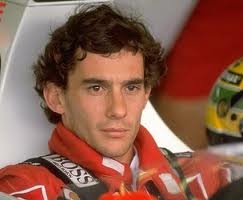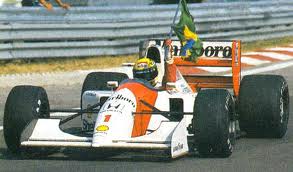Skoeman Reflects – Ayrton Senna
 Honesty is probably the best place to start here. I didn’t care much for Ayrton Senna da Silva when he was driving in Formula One. To qualify that a little, I was only in my teens. I didn’t really see him as a man either; he was just a yellow helmet in a car repeatedly taking points off my hero, Alain Prost. When I first started watching Formula 1, I was around ten years old. Ayrton Senna was just starting out with Toleman F1 and Alain Prost was the man of the moment. I quickly hitched my wagon behind him and McLaren. McLaren are still the team I follow today, almost with religious fervour.
Honesty is probably the best place to start here. I didn’t care much for Ayrton Senna da Silva when he was driving in Formula One. To qualify that a little, I was only in my teens. I didn’t really see him as a man either; he was just a yellow helmet in a car repeatedly taking points off my hero, Alain Prost. When I first started watching Formula 1, I was around ten years old. Ayrton Senna was just starting out with Toleman F1 and Alain Prost was the man of the moment. I quickly hitched my wagon behind him and McLaren. McLaren are still the team I follow today, almost with religious fervour.
The battle of Senna and Prost was not truly joined until the 1988 season when they were teamed together at McLaren. McLaren took 15 out of the 16 races that season and still remains one of the greatest achievements in Formula 1 history. The problem here was that it sparked a war within the team. Prost became convinced that Senna was getting better equipment and different instructions from the team. There is a great anecdote from commentating legend Murray Walker which highlights this fact. Mr Walker was waiting to interview Prost after a qualifying session and Prost asked him to wait by the McLaren motor home until the post-qualifying debriefing session finished. Murray waited for some time, hours passed before Prost exited in a huff. “Goodness Alain,” said Walker, “what could you have possibly been talking about for all that time?’ Prost quickly replied, “Oh, the debrief finished ages ago, I just didn’t want to be first to leave.”
 The war continued into the 1989 season and ended when Prost left the team and joined Ferrari for 1990. I was a little miffed by this, I still supported McLaren, but I would never support Senna. This upstart had come into the team and forced out my man, Prost was ever the hero and Senna the villain. When Senna left McLaren and joined Williams in 1994 I was happy. I could proudly support my team once more. In 1993 Williams were clearly the dominant team with their all-singing, all-dancing, active everything FW-15C. With Alain Prost back at the wheel for his last season, they won quickly and easily. Senna wanted to join the team with the fastest car and at that time it was Williams. Prost went, Senna came in.
The war continued into the 1989 season and ended when Prost left the team and joined Ferrari for 1990. I was a little miffed by this, I still supported McLaren, but I would never support Senna. This upstart had come into the team and forced out my man, Prost was ever the hero and Senna the villain. When Senna left McLaren and joined Williams in 1994 I was happy. I could proudly support my team once more. In 1993 Williams were clearly the dominant team with their all-singing, all-dancing, active everything FW-15C. With Alain Prost back at the wheel for his last season, they won quickly and easily. Senna wanted to join the team with the fastest car and at that time it was Williams. Prost went, Senna came in.
The regulatory body had different ideas and late in the piece changed the regulations to ban these advancements. How much this would have to do with Senna’s death early in the 1994 season has never, to my mind, been properly investigated as most of the focus was placed on the Williams F1 team. Williams had to scramble to remove the aids and then rebuild the car without them. It takes months to design an F1 car, to make sure that all the pieces work together. The Williams car was designed around their clever suspension and I have always wondered if that by removing it the car became un-driveable. In the previous three races Senna struggled to find a set-up, struggled to find pace in the car. That something broke on the car is beyond doubt but still, I wonder if he simply drove beyond the limits of the car once too often.
I will always remember watching the San Marino Grand Prix. I still remember exactly where I was. When Senna crashed in that race, and was later pronounced dead I remember feeling, well, nothing. No emotion whatsoever. The next race came about a fortnight later. At this time Channel 9 had the broadcasting rights to Formula 1 in Australia. Because of this there was no lead up to the races itself. If you were lucky you caught snippets of qualifying highlights on the Sunday sports programs, otherwise, as far as Australia was concerned Formula 1 didn’t exist. Also remember that there was no internet, no easy way to quickly came to terms with what had occurred in the preceding sessions. I had no idea what was planned for the next race at Monaco.
The cars were on their parade lap when Channel 9 moved to the ‘live feed’. They slowly moved into the grid spots and it quickly became apparent that the two spots at the front were not going to be filled. It had been decided that in honour of Senna and Roland Ratzenberger, who also died at San Marino, the two front spots would remain free. Then they came, in a great endless torrent my tears starting flowing. It suddenly dawned on me that two great men were gone, one largely greater than the other, but both still great. I would never again see the familiar yellow helmet hunting down rivals and doing things with a car that often left mouths agape. The memory of that moment still causes goosebumps and it is one that I will never forget.
So it came to pass, about four weeks ago, that I found myself in a movie cinema, staring at the screen. Those same scenes from the 1994 San Marino Grand Prix flashed up and, once again, so did the tears. If you still have not seen the Ayrton Senna movie, remarkably enough called, Senna, then I would urge you to do so. My views about Ayrton Senna have largely changed over time. The man was a saint. Not on the race track, but in the real world. He was still quite happy to be a villain on the track but this movie confirmed everything I have read since his death. He was a private individual, deeply religious, who loved racing but hated the bullshit that came with it, the politics, the movie captures this beautifully.
Ayrton Senna was an enigma. His work behind the wheel of Formula 1 cars is well documented, what is, or was, not so widely known is his work with charity organisations in his beloved Brazil. Ayrton came from wealth. The poverty in Brazil upset him greatly, particularly the way it affected children. With the majority of Brazilian sport stars of the time, it was almost standard to become famous and then pretend that you had never heard of Brazil. Ayrton wasn’t like this, he was immensely proud of his Brazilian heritage. In time he set up the Senna Foundation which has since raised millions of dollars to help hospitals and children’s services. During the movie you begin to understand why his death hit the country hard, think Diana but a whole lot bigger. I don’t think the world will ever see another Ayrton Senna. Others have won more races, won more championships, but no-one ever drove a car quite like Ayrton. For two hours he kept the car on knife edge, doing fuel economy equations in his head. Others have done more in charity, helped more people but Senna’s name lives on in Brazil as the good work of the Senna Foundation continues, his sister Vivianne at the helm. Strangely enough his greatest rival, Alain Prost, is one of the directors. No, we will never see another Senna and the world will be poorer for it.
by Skoeman For more Skoeman articles: Skoeman Website
Category: News






Connect
Connect with us on the following social media platforms.